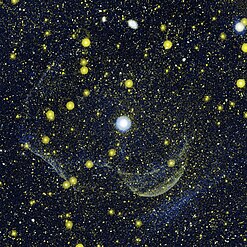Z Camelopardalis
| Observation data Epoch J2000.0 Equinox J2000.0 (ICRS) | |
|---|---|
| Constellation | Camelopardalis |
| Right ascension | 08h 25m 13.199s[2] |
| Declination | +73° 06′ 39.28″[2] |
| Apparent magnitude (V) | 9.8 to 14.5[3] |
| Characteristics | |
| Spectral type | pec(UG)+G1[3] |
| Variable type | UGZ[3] |
| Astrometry | |
| Radial velocity (Rv) | −38.0[4] km/s |
| Proper motion (μ) | RA: −9.003[2] mas/yr Dec.: −19.078[2] mas/yr |
| Parallax (π) | 4.4369 ± 0.0403 mas[2] |
| Distance | 735 ± 7 ly (225 ± 2 pc) |
| Other designations | |
| Database references | |
| SIMBAD | data |
Z Camelopardalis (Z Cam) is a cataclysmic variable star system in the northern constellation of Camelopardalis. It has an apparent visual magnitude which varies between 9.8 and 14.5. This system is the prototype star for the family of Z Camelopardalis variable stars: dwarf novae with standstills at a brightness intermediate between their maxima and minima.[3] It may be the same bright nova that was recorded by Chinese astrologers in the autumn of 77 BCE.[6]
Z Camelopardalis was discovered photographically in 1904 by Henry Park Hollis during work for the Astrographic Catalogue.[7] It is surrounded by an extensive shell thought to have been ejected in a nova explosion,[8] the largest known of its type. The size and expansion of this shell sets a firm lower limit since the last eruption of at least 220 years.[6]
Gallery
[edit]-
Z Camelopardalis light curve showing a characteristic standstill interrupting the otherwise regular eruptions
-
Gas shell Around Z Camelopardalis
-
Z Camelopardalis in ultraviolet
References
[edit]- ^ "Download Data". aavso.org. AAVSO. Retrieved 1 October 2021.
- ^ a b c d e Brown, A. G. A.; et al. (Gaia collaboration) (August 2018). "Gaia Data Release 2: Summary of the contents and survey properties". Astronomy & Astrophysics. 616. A1. arXiv:1804.09365. Bibcode:2018A&A...616A...1G. doi:10.1051/0004-6361/201833051. Gaia DR2 record for this source at VizieR.
- ^ a b c d Samus, N. N.; et al. (2017). "General Catalogue of Variable Stars". Astronomy Reports. 5.1. 61 (1): 80–88. Bibcode:2017ARep...61...80S. doi:10.1134/S1063772917010085. S2CID 125853869.
- ^ Duflot, M.; et al. (1995). "Vitesses radiales. Catalogue WEB: Wilson Evans Batten. Subtittle: Radial velocities: The Wilson-Evans-Batten catalogue". Astronomy and Astrophysics Supplement Series. 114: 269. Bibcode:1995A&AS..114..269D.
- ^ "Z Cam". SIMBAD. Centre de données astronomiques de Strasbourg. Retrieved 2020-11-15.
{{cite web}}: CS1 maint: postscript (link) - ^ a b Shara, Michael M.; et al. (September 2012). "The Inter-eruption Timescale of Classical Novae from Expansion of the Z Camelopardalis Shell". The Astrophysical Journal. 756 (2): 6. arXiv:1205.3531. Bibcode:2012ApJ...756..107S. doi:10.1088/0004-637X/756/2/107. S2CID 37111481. 107.
- ^ "New Variable Stars found on the Astrographic Plates at the Royal Observatory, Greenwich". Monthly Notices of the Royal Astronomical Society. 64 (9): 837–838. 1904. Bibcode:1904MNRAS..64..837.. doi:10.1093/mnras/64.9.837.
- ^ Shara, Michael M.; et al. (2007). "An ancient nova shell around the dwarf nova Z Camelopardalis". Nature. 446 (7132): 159–162. Bibcode:2007Natur.446..159S. doi:10.1038/nature05576. PMID 17344847. S2CID 4428527.
External links
[edit]- Price, Aaron (April 1999). "Z Camelopardalis". Variable Star of the Month. AAVSO. Retrieved 2020-11-16.




